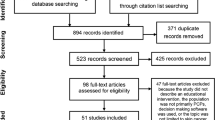Abstract
Skin cancer, especially malignant melanoma, continues on the increase. Different interventions are attempting to impact on this problem. The approach used by the Partners in Health Sciences program at the University of Arkansas for Medical Science is to both “train” and, importantly, “equip” classroom teachers and school nurses in a “Healthy Skin” professional development curriculum. Each participant not only received face-to-face interactive content training in a workshop setting that lasted 6 h; each also received a resource kit of supplies, materials, and equipment used in the workshop and designed for the trainee to use with students in a classroom/school setting. This single “hit” professional development event then can be replicated by each trainee annually for the span of her/his teaching/school-nursing career. A total of 588 trainees participated in “Healthy Skin” workshops that were held in 17 communities throughout the state. Participants attended from 188 different towns/cities. Of those in attendance, 511 (87 %) were females, 77 (13 %) males, 81 % Caucasian, 16 % African Americans, and the remaining 3 % self-identified as “other”. There were 471 teachers, 85 nurses, and 32 “others” (administrators, school counselors). Trainees completed anonymous pre/post test measures with an increase in knowledge of 28.5 %. A short-term evaluation was conducted at the end of the workshop. After a minimum of 6 months had elapsed, a long-term evaluation was used to capture data on how the workshop experience transferred into new curricular/learning activities for the students of the workshop participants. There was a high level of satisfaction with the workshop experience and use of workshop content and resource kits. Our experiences in this type of professional development outreach provide a model of how institutions of higher education could contribute to the professional development of K-12 teachers and their students in any content area.
Similar content being viewed by others
References
National Cancer Institute (2015) Melanoma. Retrieved 15 May 2015 from: http://www.cancer.gov/cancertopics/types/melanoma. Accessed 1 June 2015
Burns ER (2014) Cancer prevention and control: where are the kids? J Cancer Educ 29:209–210
Burns ER (2012) Healthy lungs: cancer education for middle school teachers using a “train and equip” method. J Cancer Educ 27(1):179–185
Burns ER (2008) Use of the published Lance Armstrong cancer story to teach health science content to high school students. Amer Biol Teach 70:17–22
Burns ER (2008) Functional anatomy of the cardiovascular system: professional development for preK-3 teachers using a “train and equip” method results in learning opportunities for students. Anat Sci Ed 1:119–125
Burns ER, Lindsey MS (2004) Cancer education and cancer prevention education for K-12 teachers and students. J Cancer Educ 19:105–110, 210 J Cancer Educ (2014) 29:209–210
Burns ER (2002) Anatomy of a successful K-12 educational outreach program in the health sciences—eleven years experience at one medical sciences campus. Anat Rec (New Anatomist) 269:181–193
Environmental Protection Agency Sun-Wise for kids URL http://www.epa.gov/sunwise/kids/
Foote JA, Poole CM (2013) Brief questions highlight the need for melanoma information campaign. J Cancer Educ 28:611–616
Kauffman RD, Shah MS, Kauffman RM (2010) Patient education cards for skin cancer detection and treatment. J Cancer Educ 25:184–187
Kamell JM, Rietkerk W, Lam K, Phillips JM, Wu JJ, McCullough JL, Linden KG, Osann K (2011) Medical students educate teens about skin cancer: what have we learned? J Cancer Educ 26:153–155
Hernandez C, Wang S, Abraham I, Angulo MI, Kim H, Meza JR, Munoz A, Rodriguez L, Uddin S (2014) Evaluation of educational videos to increase skin cancer risk awareness and sun-safe behaviors among adult Hispanics. J Cancer Educ 29:563–569
Cercate MC, Nagore F, Ramazzotti V, Sperduti GC (2013) Improving sun-safe knowledge, attitude and behavior in parents of primary school children: a pilot study. J Cancer Educ 28:151–157
Marble N, Loescher LJ, Lim KH, Hiscox H (2010) Use of technology for educating melanoma patients. J Cancer Educ 25:445–450
Bichakjian CK, Schwartz JL, Wang TS et al (2002) Melanoma information on the Internet: often incomplete—a public health opportunity? J Clin Oncol 20:134–141
Finnie RKC, Felder TM, Linder SK, Mullen PD (2010) Beyond reading level: a systematic review of the suitability of cancer education print and web-based materials. J Cancer Educ 25:497–505
Seidel N, Stoelzel F, Garzarolli M, Herrmann S, Breitbart EW, Berth H, Baumann M, Ehninger G (2013) Sun protection training based on a theater play for preschoolers: an effective method for imparting knowledge on sun protection. J Cancer Educ 28:435–438
Acknowledgments
This work was financially supported by grants from the Arkansas Cancer Coalition and the Arkansas Department of Health—Comprehensive Cancer Control Section.
Author information
Authors and Affiliations
Corresponding author
Rights and permissions
About this article
Cite this article
Burns, E.R. Healthy Skin: Cancer Education for School Teachers and Nurses Using a “Train and Equip” Method. J Canc Educ 32, 72–78 (2017). https://doi.org/10.1007/s13187-016-1020-7
Published:
Issue Date:
DOI: https://doi.org/10.1007/s13187-016-1020-7



